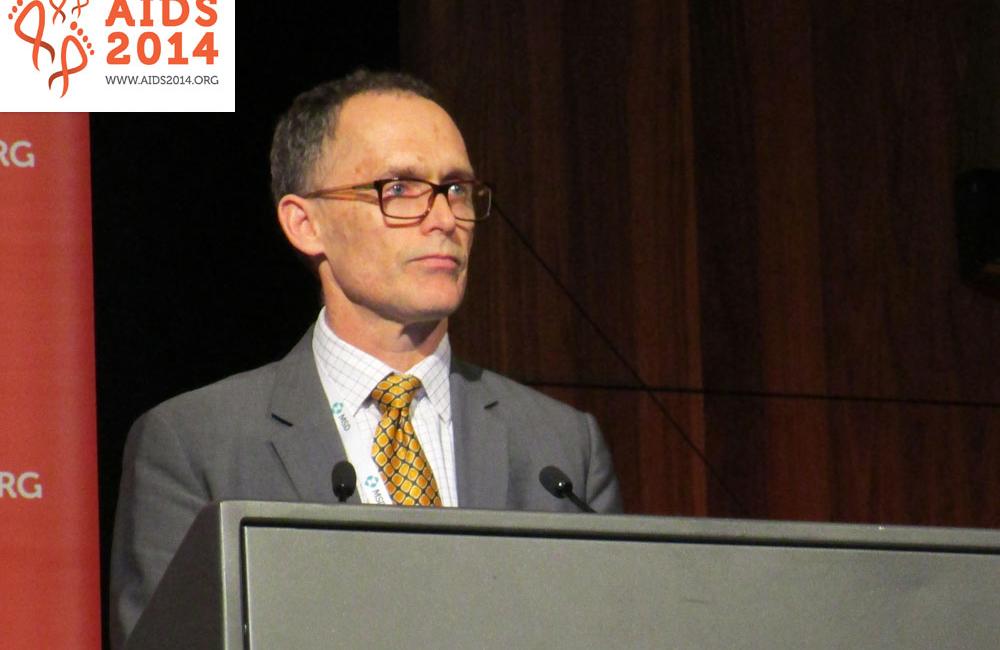
High-grade anal dysplasia is common among gay men living with HIV, but it often resolves spontaneously and routine treatment may not be beneficial, according to results from the Australian SPANC study presented on Wednesday at the 20th International AIDS Conference (AIDS 2014) in Melbourne.
Anal cancer and its precursors, anal dysplasia and neoplasia (abnormal cell growth and tissue changes), are more common among people living with HIV – especially men who have sex with men – than in the general population. Most studies indicate that prevalence has increased in the era of effective antiretroviral therapy as HIV-positive people live longer. Yet not enough is known about how best to screen for and manage anal abnormalities in this group.
Andrew Grulich from the Kirby Institute at the University of New South Wales and fellow investigators in Sydney designed the Study of the Prevention of Anal Cancer (SPANC) to learn more about the natural history of anal human papillomavirus (HPV) infection and anal cancer precursors in HIV-positive and HIV-negative gay men, including incidence, clearance and risk factors.
High-risk or oncogenic types of HPV – including HPV-16 and HPV-18 – can cause anal, cervical and other genital cancers. Typically people will first develop low-grade dysplasia or squamous intraepithelial lesions (LSIL), which can progress to high-grade lesions (HSIL) and eventually carcinoma. But high-risk HPV does not always cause abnormal changes, low-grade dysplasia does not always progress to high-grade lesions or cancer, and dysplasia may regress on its own without treatment.
While some experts favour routine treatment of HSIL – which may involve chemotherapy, radiation, cauterisation (burning) or surgery – this view is controversial. HSIL is "extraordinarily prevalent" – occurring in up to half of gay men living with HIV – and treatment is extremely difficult with a high rate of recurrence and adverse events, Grulich explained. "Watchful waiting" with treatment targeted only to the highest-risk cases may be a viable alternative.
SPANC is a prospective community-based study that aims to enrol 600 men by July 2015. Participants make five study visits over three years. At each visit they receive anal swabs for HPV testing and cytology (examination of cell changes) as well as high-resolution anoscopy (viewing with a magnifying instrument). Men with visually apparent abnormalities undergo biopsy for histology assessment (examination of tissue changes). They are considered to have anal HSIL if they show either cytological or histological evidence of HSIL (grade 2 or 3 anal intraepithelial neoplasia).
This interim analysis included the first 450 men recruited through June 2014. All were aged 35 or older, with a median age of 49 years. About 30% were living with HIV.
At baseline, men living with HIV had significantly higher prevalence of anal HSIL than the HIV-negative group using the composite measure (46 vs 34%, respectively). While both groups had similar rates of HSIL according to cytology alone (20 vs 18%), abnormal histology was more common among men living with HIV (40 vs 27%).
Among 197 men without HSIL at baseline, there were 45 incident or new cases of HSIL. Overall HSIL incidence was 16 cases per 100 person-years – or about one in six men each year. However, the incidence rate was nearly twice as high for HIV-positive compared to HIV-negative men (23 vs 13 per 100 person-years, respectively), though the difference did not reach statistical significance (p = 0.061). HSIL incidence did not differ significantly by age.
Looking at HPV results, men who tested positive for HPV-16, HPV-18, or any high-risk HPV type at baseline were significantly more likely to develop HSIL. Men with persistently positive HPV-16 had a high incidence of HSIL (56 per 100 person-years), but the highest rate was seen among men who started out HPV-16 negative but became infected during the study (116 per 100 person-years). Incident HSIL was uncommon among men without chronic HPV infection
Unlike treatment trials, this natural history study allowed researchers to observe spontaneous clearance or resolution of anal lesions without therapy. Among 112 men with HSIL at baseline, 61 experienced spontaneous clearance (42 per 100 person-years), with similar rates for HIV-positive and HIV-negative men. HSIL clearance also did not differ according to age.
Men with persistent HPV-16 infection were least likely to experience spontaneous HSIL clearance (23 per 100 person-years), but those who started out HPV-16 negative and became infected during the study had a high clearance rate (96 per 100 person-years).
"HSIL is very highly prevalent in homosexual men," the researchers concluded. However, the condition is "highly dynamic." Both prevalent and incident anal HSIL were more common among gay men living with HIV, but clearance was common regardless of HIV status.
These findings "provide a very strong justification that not all high grade anal disease requires treatment, and suggests that treatment can be targeted to people with persistent high-grade disease," Grulich said, adding that most high-grade disease noticed on a single test "will simply go away."
Grulich AE et al. Incidence and clearance of anal high-grade squamous intraepithelial lesions (HSIL) in HIV positive and HIV negative homosexual men. 20th International AIDS Conference, abstract WEAB0102, Melbourne, 2014.
